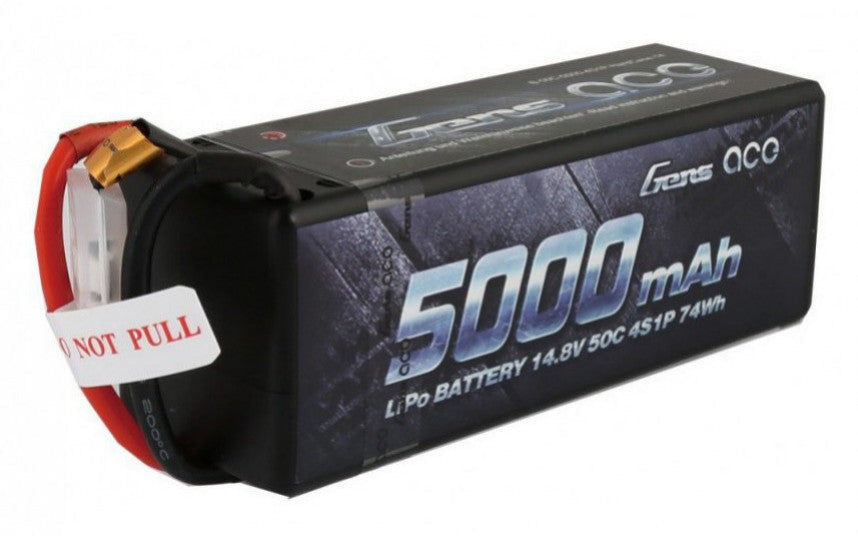Lipo vs Nimh batteries
Lipo batteries
Lithium-polymer batteries , also called LiPo batteries , are today used in many consumer electronic vehicles. They have become very popular in model making thanks to their small size, light weight and high performance. They nevertheless have certain disadvantages such as their fragility and a relatively short lifespan (between 150 and 250 charge cycles).
Nimh batteries
Lighter and more efficient than NiCd, Nimh batteries are commonly used in model making. They are less dangerous with almost no fire risk and are therefore more suitable for children. On the other hand, they are also heavier and limited in size with poorer performance than Lipo.
What do the numbers on a Lipo battery mean?
The numbers written on Lipo batteries allow you to understand its properties. There are three markings that you absolutely must understand to know if the battery is suitable for your RC vehicle.

The voltage
A Lipo cell has a voltage of 3.7 V (or 3.8 V in the case of HV batteries). You will often find higher values, for example on the battery above: 14.8 V means that there are four cells connected in series because the voltage adds up. In the world of modeling you will often find 2S batteries to indicate the presence of 2 cells, 3S batteries for 3 cells, 4S batteries for 4 cells and so on.
The battery voltage influences the rotation speed of the electric motor , so it will determine the speed of your radio-controlled vehicle. For brushless motors, power is rated in kV (RPM per volt). For example, a motor with a power of 3,500 kV will rotate at 3,500 rpm for each volt so, with a 2S Lipo battery it will rotate at 25,900 rpm, with a 3S battery at 38,850 rpm, etc.
To help you here is a small summary table:
| Designation | Number of cells | Tension |
| 1S | 1 | 3.7V |
| 2S | 2 | 7.4V |
| 3S | 3 | 11.1V |
| 4S | 4 | 14.8V |
| 5S | 5 | 18.5V |
| 6S | 6 | 22.2V |
| 7S | 7 | 25.9V |
The capacity
The capacity of a battery determines how long you can use it before it runs out of charge. It is expressed in milliamps (mAh). The higher the value, the greater the range of the electric vehicle . In modeling the average is 5000 mAh but some batteries can go up to 12000 mAh. However, a large capacity battery is heavier and bulkier than its counterparts (check the dimensions of the battery to ensure that it fits in your vehicle).
Discharge rate
The C value is the maximum capacity without danger of continuous discharge of your battery . For example, on the battery above, 50C means you can discharge the battery at a power of up to 50 times the battery capacity continuously or 6000 mAh 50C = 6A x 50 = 300A continuous discharge max. Going above the max continuous discharge can cause the battery to deteriorate more quickly at best and, at worst, cause the battery to catch fire. Always choose a discharge rate well above your maximum continuous discharge because depending on the type of terrain, the size of the tires or even the weight of the vehicle this can vary.
How do I take care of my Lipo battery?
Precautions to take
Lipo batteries offer power and autonomy to model enthusiasts, but these advantages come at a price. If a Lipo battery is damaged, lithium being very reactive in contact with water or humidity, toxic gas emissions and a fire may occur. However, this type of battery poses no danger as long as you follow certain safety instructions.
- Immediately get rid of a lipo battery that has started to swell, is damaged or punctured. by handing it over to a center approved for the management of dangerous products.
- Do not attempt to charge a damaged battery.
- After a crash, remove your battery, place it in a secure space (far from any flammable material) and observe it for 30 minutes, making sure to maintain a safe distance. After this period, and if the battery appears stable, has not leaked and shows no signs of deterioration, you can use it again while remaining vigilant.
- Do not leave the battery in a vehicle or directly exposed to sunlight.
- If your lipo battery catches fire, do not put out the fire with water but use sand or an extinguisher for electrical fires.
Charging a Lipo battery
New Lipo batteries are always charged to 40% of their total capacity because for manufacturers this is the best way to store them for a long time. A first charge is therefore necessary before use. Do not use the Fast Charge function during the first charge cycles and do not use a battery charged less than 50%. This is to preserve their lifespan and performance. Generally speaking, Lipo batteries should never be discharged below 3 volts per cell otherwise they will be damaged.
Before charging a Lipo battery, it must be removed from the RC vehicle and inspected to ensure that it is not deformed or has any cuts. You must use a specific charger for Lipo batteries and never place it on a flammable surface (carpet, wood, etc.) or inside a vehicle with the engine running. You also need to monitor the battery throughout the charging time.
Storing a Lipo battery
The ideal place to store your Lipo batteries is ventilated, cool and dry, with a temperature between 5°C and 27°C. The batteries will be stored half-charged (i.e. approximately 3.8 volts per cell): on modern chargers there is a "storage" function to obtain the storage voltage. During transport, the ambient temperature should be between 5°C and 50°C away from sunlight. You can also use a fireproof bag for storing or charging your Lipo batteries to prevent any accidents.





